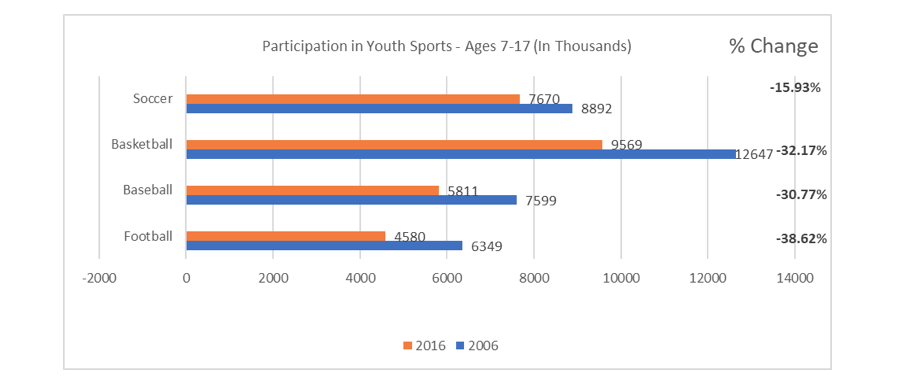Sports are one of America’s favorite past times. Watching, playing, talking about, it doesn’t matter, we all love sports in some form or fashion. For some, it is a way to connect with family, others it is a way of staying physically active. No matter its significance to you, the danger of sports slowly disappearing is very real. Every professional athlete started by playing sports as a kid, and if the kids stop playing youth sports, what will be the outcome? Let's take a look at some of the numbers.

Numbers Don’t Lie
Between skyrocketing costs, sport specialization and coaches needing training, youth sports are in the midst of a crisis. Over the past decade there has been a significant decline in youth sports, primarily in the big four, which are listed in the graph above. You can see this decline over the past 10 years has been very significant for youth sports. But what is causing this decline? There is not exactly one factor that you can pinpoint this decline to, but instead there are many things that have led to this drop in participation. Experts believe part of the blame is on what they call an “up or out” mentality in youth sports. Travel leagues, ones that can sometimes cost thousands of dollars to join, have crept into increasingly younger age groups, and they take the most talented young athletes for their teams. The children left behind either grow unsatisfied on regular recreational teams or get the message that the sport isn’t for them. Another huge impact on youth sports is todays technology. In todays society we are so wrapped up in the digital age, so much so, that we often let the deciding factor for if we want to go somewhere to be if there is free Wi-Fi. Kids are so distracted nowadays that playing sports or even being physically active come second to them after their technology. Could we see sports disappear completely in the next 25, 50, or 75 years? Let's hope not.
What’s Being Done
Organized sports have long been regarded as a valuable defense against increasing rates of disease-inducing inactivity among America's youth, and declines in youth sports participation could bear long-lasting consequences. Youth sports make up a $15 billion industry, losing out on this would be detrimental. So, let's look at the initiatives that are taking place to take action in this fight against declining participation in youth sports. In 2007, the NFL started a program called Play-60 which is still active today and arguably the most effective tool in this ongoing battle. The Play-60’s purpose is to get kids to go outside for 60 minutes a day to, preferably play football, but in general to be active outside for 60 minutes each day. Another step being taken is that local communities and leagues are offering free trainings for parents to become coaches. Often times its not the lack of involvement for parents, it’s the lack of knowledge or skills on how to coach youth sports teams. Hopefully with the proper trainings this will be able to bridge the gap. In todays changing times there is a lot of work to be done to reverse this declining trend of participation in youth sports, and I will wrap up with one of my favorite quotes from one of the greatest coaches to ever live. "The only place success comes before work is in the dictionary." - Vince Lombardi
This blog post was written by Samford University student Greg Buszka.
References:
S. (n.d.). Youth Sports: Ages 7-17 as % of Participants, By Sport. Retrieved December 09, 2017, from http://sportsmarketanalytics.com.ezproxy.samford.edu/Research.aspx?subrid=1059
Bogage, J. (2017, September 06). Youth sports study: Declining participation, rising costs and unqualified coaches. Retrieved December 09, 2017, from https://www.washingtonpost.com/news/recruiting-insider/wp/2017/09/06/youth-sports-study-declining-participation-rising-costs-and-unqualified-coaches/?utm_term=.6bfa0e67e718
